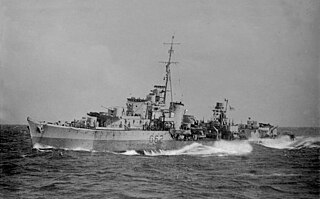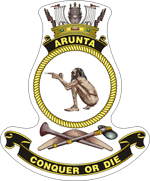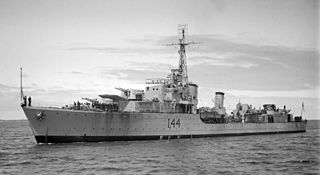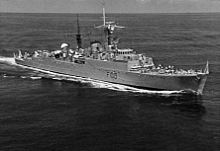
HMAS Bataan (D9/I91/D191) was a Tribal-class destroyer of the Royal Australian Navy (RAN). Laid down in 1942 and commissioned in 1945, the destroyer was originally to be named Chingilli or Kurnai but was renamed prior to launch in honour of the US stand during the Battle of Bataan.

HMAS Napier (G97/D13) was an N-class destroyer serving in the Royal Australian Navy (RAN) during World War II. Built during 1939 and 1940, the destroyer was commissioned into the RAN, although she was ordered and owned by the British government. During 1941, Napier operated in the Mediterranean, before being transferred to the British Eastern Fleet at the start of 1942, then to south Atlantic operations in early 1944. In 1945, Napier was assigned to the British Pacific Fleet, and spent the rest of World War II in the fight against Japan. After the war's end, the destroyer was decommissioned and returned to the British. She was sold off in 1955, and broken up in 1956.

HMAS Nepal (G25/D14) was an N-class destroyer of the Royal Australian Navy (RAN). Launched in 1941 as Norseman, the ship suffered significant damage during an air raid on the John I. Thornycroft and Company shipyard, and during repairs was renamed to recognise Nepal's contribution to the British war effort. Although commissioned into the RAN in 1942, the ship remained the property of the Royal Navy.

HMAS Nestor (G02) was an N-class destroyer of the Royal Australian Navy (RAN). Built in Scotland, Nestor was commissioned in February 1941; although manned by Australians and commissioned as an Australian warship, she remained the property of the Royal Navy.

HMAS Nizam (G38/D15) was an N-class destroyer of the Royal Australian Navy (RAN). The destroyer, named after Osman Ali Khan, the last Nizam of Hyderabad, was commissioned into the RAN in 1940, although the ship remained the property of the Royal Navy for her entire career.

HMAS Quadrant (G11/D11/F01), named for the navigational instrument, was a Q-class destroyer operated by the Royal Navy as HMS Quadrant (G67/D17) during World War II, and the Royal Australian Navy (RAN) from 1945 to 1957. The ship was built during the early 1940s as one of the War Emergency Programme destroyers, and entered service in 1942.

HMAS Quickmatch (G92/D21/D292/F04) was a Q-class destroyer operated by the Royal Australian Navy (RAN). Although commissioned into the RAN in 1942, the ship was initially the property of the Royal Navy. Quickmatch served with both the British Eastern Fleet and British Pacific Fleet during World War II. In the 1950s, the destroyer was converted into an anti-submarine frigate. In 1957, Quickmatch operated in support of Malaya during the Malayan Emergency. The ship remained in service until 1963, and after use as an accommodation ship, was sold for scrap in 1972.

HMAS Queenborough (G70/D270/F02/57) was a Q-class destroyer that served in the Royal Navy (RN) and Royal Australian Navy (RAN).

HMAS Kalgoorlie (J192/B245/A119), named for the city of Kalgoorlie, was one of 60 Bathurst-class corvettes constructed during World War II and one of 20 built for the Admiralty but manned by personnel of and commissioned into the Royal Australian Navy (RAN).

HMS Quality (G62/D18) was a Q-class destroyer built for the Royal Navy. Entering service in 1942, the destroyer served in several theatres of World War II. Following the war's conclusion, the ship was transferred to the Royal Australian Navy (RAN), commissioning as HMAS Quality (G62/D262) in late 1945. Unlike her sister ships, which were refitted as anti-submarine frigates, Quality was not modified, decommissioned after only 59 days of service, and was sold for scrap in 1958.

HMAS Stuart was a British Scott-class flotilla leader. The ship was built by Hawthorn Leslie and Company for the Royal Navy during World War I, and entered service at the end of 1918. The majority of the destroyer's British service was performed in the Mediterranean, and in 1933 she was transferred to the Royal Australian Navy. Although placed in reserve in 1938, Stuart was reactivated at the start of World War II to lead the Australian destroyer force, nicknamed the "Scrap Iron Flotilla" by German propagandists.

HMAS Hobart was a modified Leander-class light cruiser which served in the Royal Australian Navy (RAN) during World War II. Originally constructed for the Royal Navy as HMS Apollo, the ship entered service in 1936, and was sold to Australia two years later. During the war, Hobart was involved in the evacuation of British Somaliland in 1940, fought at the Battle of the Coral Sea and supported the amphibious landings at Guadalcanal and Tulagi in 1942. She was torpedoed by a Japanese submarine in 1943, then returned to service in 1945 and supported the landings at Tarakan, Wewak, Brunei, and Balikpapan. Hobart was placed in reserve in 1947, but plans to modernise her and return her to service as an aircraft carrier escort, training ship, or guided missile ship were not followed through. The cruiser was sold for scrapping in 1962.

HMAS Arunta (I30/D5/D130) was a Tribal-class destroyer of the Royal Australian Navy (RAN). Named for the Arrernte Aboriginal peoples, the destroyer was laid down in 1939 and commissioned into the RAN in 1942.

HMAS Warramunga (I44/D123) was a Tribal-class destroyer of the Royal Australian Navy (RAN). Built during World War II, the destroyer entered service in late 1942. She was initially assigned to convoy escort duties, but was assigned to the joint Australian-American Task Force 74 in 1943, and was involved in supporting numerous amphibious landings through the South-east Asian region until the end of the war. From 1950 and 1952, Warramunga fought in the Korean War, then was converted into an anti-submarine destroyer. Returning to service in 1954, the destroyer was one of the first RAN ships to operate with the Far East Strategic Reserve, and undertook two tours with the organisation before she was decommissioned in 1959 and sold for ship breaking in 1963.

HMAS Norman (G49/D16) was an N-class destroyer operated by the Royal Australian Navy (RAN) during World War II. Entering service in 1941, the ship was on loan from the Royal Navy.

HMAS Vampire was a V-class destroyer of the Royal Navy (RN) and Royal Australian Navy (RAN). Launched in 1917 as HMS Wallace, the ship was renamed and commissioned into the RN later that year. Vampire was lent to the RAN in 1933, and operated as a depot tender until just before World War II. Reactivated for war service, the destroyer served in the Mediterranean as part of the Scrap Iron Flotilla, and was escorting the British warships HMS Prince of Wales and HMS Repulse during their loss to Japanese aircraft in the South China Sea in December 1941. Vampire was sunk on 9 April 1942 by Japanese aircraft while sailing with the aircraft carrier HMS Hermes from Trincomalee.

HMAS Vendetta (D69/I69) was a V-class destroyer that served in the Royal Navy and the Royal Australian Navy (RAN). One of 25 V class ships ordered for the Royal Navy during World War I, Vendetta entered service in 1917.

The history of the Royal Australian Navy traces the development of the Royal Australian Navy (RAN) from the colonisation of Australia by the British in 1788. Until 1859, vessels of the Royal Navy made frequent trips to the new colonies. In 1859, the Australia Squadron was formed as a separate squadron and remained in Australia until 1913. Until Federation, five of the six Australian colonies operated their own colonial naval force, which formed on 1 March 1901 the Australian Navy's (AN) Commonwealth Naval Force which received Royal patronage in July 1911 and was from that time referred to as Royal Australian Navy (RAN). On 4 October 1913 the new replacement fleet for the foundation fleet of 1901 steamed through Sydney Heads for the first time.

HMAS Yarra (U77), named for the Yarra River, was a Grimsby-class sloop of the Royal Australian Navy (RAN) that served during World War II. Commissioned in 1936, Yarra spent the early part of the war in Australian waters, then was transferred to the East Indies Station in 1940. The sloop operated in the Red Sea, then was involved in the Anglo-Iraqi War and the Anglo-Soviet invasion of Iran. After operating as part of the Tobruk Ferry Service in the Mediterranean during November, Yarra was reassigned to Southeast Asia in response to Japanese attacks. On 4 March 1942, Yarra was attacked and sunk by a force of Japanese cruisers and destroyers while attempting to protect ships withdrawing to Australia.

HMAS Gawler (J188/B241/A115), named for the town of Gawler, was one of 60 Bathurst-class corvettes constructed during World War II and one of 20 built for the Admiralty but manned by personnel of and commissioned into the Royal Australian Navy (RAN). The ship was laid down by BHP at its Whyalla shipyard in early 1941, launched later that year, and commissioned in 1942.






















